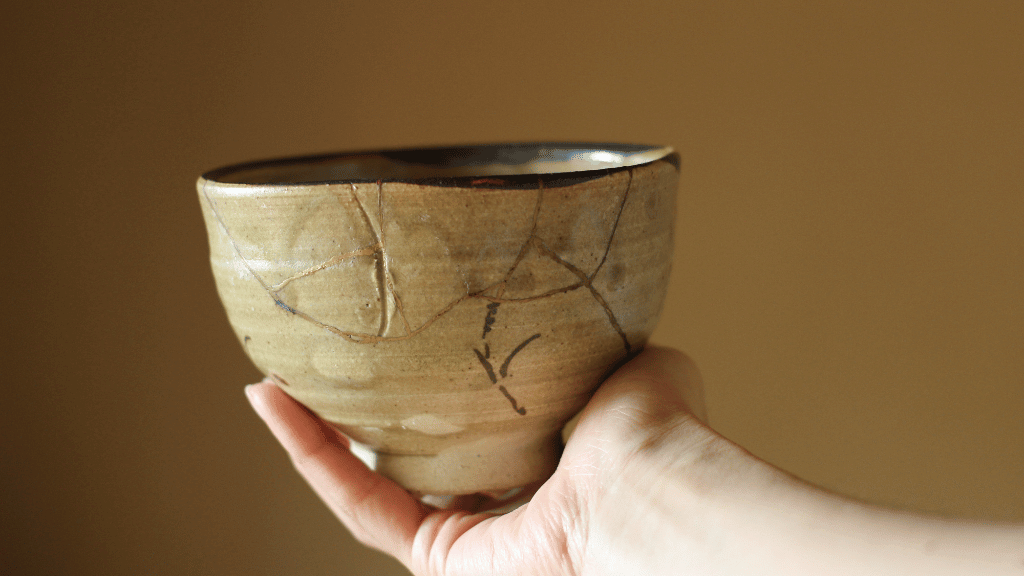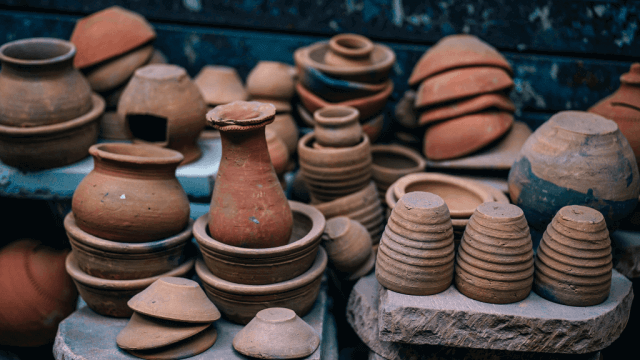To fix cracks in fired pottery, follow these steps: 1) Clean the cracked area with soap and water, and let it dry.
2) Mix a high-quality ceramic epoxy adhesive according to the manufacturer’s instructions.
3) Apply the epoxy to the cracks using a spatula, toothpick, or small brush.
4) Press the cracked parts together and hold them until the adhesive sets.
5) Remove excess adhesive using a knife or cloth.
6) Allow the repaired pottery to cure according to the adhesive’s directions.
Keep in mind that repaired pottery may not be food-safe or suitable for high temperatures.
Understanding Cracks in Fired Pottery
Fired pottery cracks can occur for various reasons, such as thermal stress, improper drying, or uneven firing.
Repairing cracks can restore the appearance and functionality of the pottery, but it won’t be as strong as its original state.
It’s also essential to know that repaired pottery may not be food-safe or suitable for high temperatures.
Preparing the Cracked Pottery
Cleaning the Pottery
Before repairing the cracks, ensure the pottery is clean and free from dust or debris.
Wash the cracked area with mild soap and water using a soft cloth or sponge.
Rinse thoroughly and let it dry completely.
Selecting the Right Adhesive
Choose a high-quality ceramic epoxy adhesive designed for repairing ceramics.
Ensure it’s compatible with the type of pottery you have, and follow the manufacturer’s instructions for mixing and curing times.
Repairing Cracks in Fired Pottery
Applying the Epoxy
Using a spatula, toothpick, or small brush, apply the mixed epoxy adhesive to the edges of the crack.
Be sure to fill the entire crack, but avoid using excessive amounts of epoxy, as it may create a visible line after the repair.
Aligning and Securing the Pieces
Press the cracked parts together, aligning them carefully, and hold them in place until the adhesive sets.
It may be helpful to use painter’s tape, rubber bands, or clamps to keep the pieces in position while the adhesive cures.
Removing Excess Adhesive
After the epoxy has partially set, remove any excess adhesive using a clean cloth, knife, or cotton swab.
Be gentle to avoid disturbing the repair or scratching the pottery’s surface.
Final Curing and Precautions
Allow the repaired pottery to cure for the recommended time, as indicated by the adhesive’s instructions.
Take note that the repaired pottery may not be suitable for high temperatures or food use, as the adhesive may not be food-safe.
For decorative purposes, the pottery can be displayed and enjoyed for years to come.
Preventing Cracks in Pottery
While repairing cracks can enhance a fired pottery piece’s appearance and functionality, preventing cracks from occurring ensures the pottery lasts longer and maintains its strength.
Here are some tips to avoid cracks in fired pottery:
Proper Clay Preparation
Start with well-prepared clay by removing air bubbles and other impurities that could contribute to cracking.
Wedging the clay thoroughly can help with this process.
Even Drying Process
Ensure the pottery dries uniformly by controlling the drying time and conditions.
Covering the pottery with a plastic sheet or setting it in a humidity-controlled environment helps prevent uneven drying and cracking.
Appropriate Firing Temperature
Confirm the clay body and glaze are compatible with the firing temperature range.
Using a kiln that enables precise temperature control is crucial to prevent over- or under-firing the pottery, which could cause cracks.
Understanding Limitations of Repaired Pottery
While the repaired pottery may appear almost as good as new, it’s crucial to be mindful of its limitations to ensure further damage does not occur.
Some points to consider include:
Strength
Although the ceramic epoxy adhesive can effectively bond the cracked pieces, the repaired pottery may not be as strong as the original, undamaged version.
So, handle it with care, as it might be more susceptible to breaking.
Water Resistance
The repaired pottery may not be as water-resistant as it was before.
The adhesive used may not provide a complete watertight seal, so using the pottery to hold water or exposing it to moisture could cause damage to the repair.
Temperature Tolerance
The adhesive used in the repair process may have a lower temperature tolerance than the pottery’s original components.
This factor limits the repaired pottery’s functionality, making it unsuitable for cooking or other high-temperature applications.
Alternative Solutions for Cracked Pottery
If repairing the fired pottery is not a suitable solution or if the repaired pottery’s limitations are undesirable, alternative approaches can help extend its lifespan or transform its purpose:
Repurposing
Consider repurposing the cracked pottery into a decorative or functional item, like a planter, paperweight, or mosaic base.
Understanding Kintsugi
Kintsugi is a traditional Japanese method to repair broken pottery by using a gold-infused lacquer.
This technique embraces the pottery’s imperfections and transforms it into a unique and valuable piece of art.
Learning Kintsugi can be an exciting alternative to fixing cracked pottery with adhesive.
Frequently Asked Questions on Fixing Cracks in Fired Pottery
In the world of pottery repairs, several questions arise frequently when it comes to fixing cracks.
Here is a collection of common inquiries with clear and concise answers to help better understand the repair process and other aspects related to cracked pottery.
Can repaired pottery be used for cooking or food storage?
Generally, it is not recommended to use repaired pottery for cooking or food storage, as the ceramic epoxy adhesive may not be food-safe, resulting in potential contamination.
Additionally, the repaired pottery might not withstand high temperatures or prolonged exposure to moisture, which could weaken the repair or cause further damage.
Can I paint over the epoxy repair on my pottery?
Yes, you can paint over the epoxy repair on your pottery.
However, ensure the epoxy adhesive is fully cured before applying paint.
To achieve a natural and seamless finish, use ceramic paints that match the pottery’s original colors and finish.
It is advisable to follow the paint manufacturer’s instructions for application and curing times.
How can I preserve the repaired pottery to ensure it lasts longer?
Handle the repaired pottery gently and avoid subjecting it to high temperatures, moisture, or strong impacts.
Do not use it for food storage or cooking.
Clean the pottery gently with a soft cloth, warm water, and mild detergent, avoiding contact with the repaired area as much as possible to prevent degradation of the adhesive.
How long does it take for the ceramic epoxy adhesive to fully cure?
The curing time for ceramic epoxy adhesives varies depending on the product and the manufacturer.
Typically, the curing process can take anywhere from a few hours to several days.
Always follow the manufacturer’s instructions for the specific adhesive you are using to ensure proper curing and a successful repair.
Is it possible to fix pottery cracks without using epoxy?
While epoxy is a common and effective solution for repairing pottery cracks, other methods exist.
One alternative is Kintsugi, a Japanese technique that uses gold-infused lacquer to fix broken pottery.
This method not only repairs the cracks but also adds aesthetic value to the pottery by highlighting them in gold.
Another alternative is repurposing the cracked pottery by transforming it into a planter, mosaic base, or other functional or decorative items.











